Not the Sound of Silence
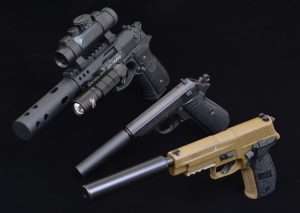
A reader recently asked about the Air Venturi faux suppressor for the threaded barrel Sig Sauer P226 ASP semi-auto air pistol, and if it either increased velocity or accuracy since it extends the length of the barrel. The answer is no, but to understand why, you need to know a little bit about how real sound suppressors (silencers) work and what effects they have on a pistol, aside from the obvious.
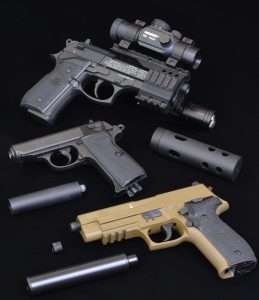
Silencers have been around for a very long time, since about 1902, and in the last 115 years there have been an infinite number of improvements in design, manufacturing, materials, and applications. What most people don’t know is that there is no such thing as a fully silenced firearm, maybe in the movies, where sound effects technicians give silencers the sounds we expect to hear. In reality, the sound varies from silencer to silencer, both by design and by the caliber of gun and type of ammunition being used. And there is no way to suppress the sounds made by a gun’s action; the cycling of a slide, for instance, makes the same noise no matter what’s hanging off the end of the barrel. With a suppressor, a pistol’s discharge is not muted but rather reduced to something akin to a snapping sound, similar to the spring tension being released when firing a small air rifle; nothing that would resemble the report of gunfire to an untrained ear.
Technically, sound suppressors deal with noise, not silence, which is achieved by lowering the sonic pressures of a firearm when it is discharged, which in turn reduces the decibel rating (dB) of the discharge. In addition to noise reduction, muzzle flash is virtually eliminated, and there are two additional byproducts; significantly reduced recoil (muzzle flip), and something modern designers call “Free Bore Boost.” The latter is the biggest surprise to those who have preconceived notions about silencers. The one expectation you have is that muzzle velocity is going to drop slightly but in many cases it goes the opposite way with modern suppressor designs.
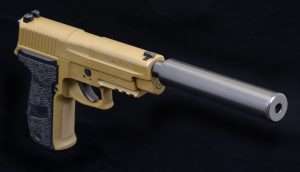
How the Real Ones Work
When a gun is fired (whether a revolver, semi-auto rifle or pistol), hot expanding gases force the bullet down the barrel. These gases are still behind the bullet as it exits the barrel and enters the suppressor. As the bullet passes through the suppressor the hot expanding gas is contained and slowed down to let it expand internally. Now if we take the silencer out of the equation, when that bullet goes down the barrel and enters the atmosphere at the muzzle the hot expanding gas vents directly into the atmosphere, and boom, it goes from being under pressure in the barrel to rapidly being released or ‘uncorked’ so to speak, and you get a big bang. To change that dynamic you need to equalize the pressure, so let’s put the suppressor back into the equation. As the bullet leaves the barrel and enters the suppressor the pressure of the expanding gases propelling it forward pass through a series of baffles which equalize it, so that when it hits the atmosphere it has already been ‘uncorked.’ As a net result, in addition to dispersing the gases and muting the sound of the discharge, the speed of the bullet as it leaves the suppressor’s muzzle is slightly increased. This, however, is a side effect of modern suppressor designs, something that 20th century silencer technology did not provide. Old style silencers used elastomer disks or neoprene wipes that the bullet had to pass through, and since the bullet actually pierced the wipes, it slowed down, and depending upon how many wipes were used determined the reduction in velocity as it left the muzzle. Today’s silencers are a wipeless design. But even they cannot increase accuracy, at least not in the way you think. That is a byproduct of another sound suppressor side effect, a significant reduction in recoil. That is what helps increase accuracy. A suppressor can also effectively shift a gun’s (or rifle’s) center of gravity making it easier to handle. By mitigating noise and lessening recoil, a silencer is also an excellent device for learning better firearm’s control and improving accuracy. The most valuable asset of a sound suppressor on a handgun or rifle, at least for most individuals, is the most basic of all, protecting the shooter and those within earshot from the high decibel report of a firearm. And that is the sound of silence.
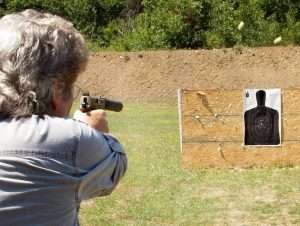
None of this, unfortunately, even remotely applies to the faux suppressor used on Sig Sauer P226 ASP models. There are air rifles with functioning and very effective sound suppressors such as the Gamo Whisper Fusion PRO spring piston air rifle, Talon SS PCP models, the superb Air Arms S510 TXTRA Ultimate Sporter FAC PCP air rifle, and the spring piston-powered Remington Express XP, to name a few and all of which use air rifle suppressors to significantly reduce dB levels. Suppressors are particularly effective with PCP models. So, yes there are airgun noise suppressors that work, but none for .177 caliber and 4.5mm semi-auto air pistols with one exception, the Hatsan AT P1 Quiet Energy Air Pistol, a multi caliber 4.5mm, 5.5mm (.22) or 6.35mm (.25) repeater that uses a 10-shot rotary magazine. As for the Sig, the threaded suppressor looks great but is just a handsome empty tube. This isn’t (or hasn’t) always been the case with faux suppressors.
To better explain this requires a little step back to the very end of the 20th century when blowback action .177 caliber BB and semi-auto 4.5mm pellet-firing air pistols were still in their infancy. Around 18 years ago, Umarex and Walther introduced the very first blowback action .177 caliber semiautomatic air pistol, the Walther PPK/S, along with one variant of that original, a special version with a treaded barrel and faux silencer; it was very James Bond of them. The Umarex Walther PPK/S was the first of its kind in two categories, the first Umarex replica airgun for .177 caliber steel BBs, and the first replica airgun with a blowback system. Even though it is in no way equal to the latest blowback action .177 caliber models for velocity or accuracy, the PPK/S has remained in production for almost two decades.
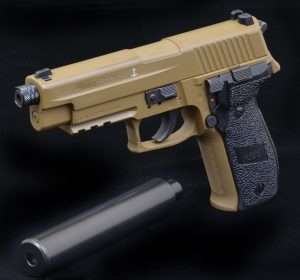
Not Only Wipeless…
That very first threaded tube to hang off the end of the PPK/S airgun’s barrel had an inner tube diameter of 7.93mm, while a .177 caliber steel BB has a diameter of 4.5mm, thus shooting a steel BB through the PPK/S faux suppressor with an opening almost twice its diameter (3.4375mm greater) rendered zero effect for increasing velocity or accuracy. It did have a 100 percent effect on looks.
The new Air Venturi faux suppressor for the Sig Sauer P226 ASP has the same 7.93mm muzzle opening as the old PPK/S faux suppressor, but it has no internal tube like the Walther design, so the inside dimension between the 7.93mm threaded muzzle of the P226 ASP and the muzzle opening of the faux suppressor is cavernous; identical to the faux suppressor’s external diameter of 23.81mm. It is like shooting the 4.5mm pellet through a pipe. Thus there is zero gain in velocity or accuracy, but that same 100 percent gain in appearances, and for appearance sake, the P226 ASP with the faux suppressor mounted is worth more than the sum of its parts, or effectiveness.
There is one noteworthy exception to this tale, another no longer available Umarex variant of the original Beretta 92FS 4.5mm pellet model. Like the PPK/S, the original 92FS version is still manufactured to this day in both blued and nickel versions, but not a special version known as the XX-TREME, which was originally built exclusively for Pyramyd AIR. This model, like the suppressor equipped PPK/S air pistol, falls into the “eclectic collectibles” category if you find one. (The original MSRP was $320 fully equipped back in 2005 when I reviewed it for Guns & Ammo).
The XX-TREME had a full size, vented faux suppressor along with Picatinny rails for mounting optics on top and tactical light and laser sighting devices on the side rails or bottom rail. It looked like something that would come out of a Navy SEAL’s go bag. The one overriding difference between the faux suppressor on the XX-TREME and others was its threading mount and internal design. The XX-TREME faux suppressor threaded into the barrel, not over it, and the first full inch of the suppressor’s internal tube was an actual barrel extension that modestly increased the velocity and accuracy of the 92FS. I’ve owned this one since 2005 and it remains the most accurate 92FS 4.5mm pellet model ever produced. While the XX-TREEM’s faux suppressor did not in any way decrease the pistol’s dB rating, it did do what this one reader wondered about, it increased the air pistol’s performance.
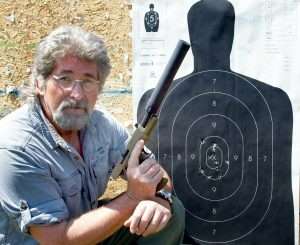
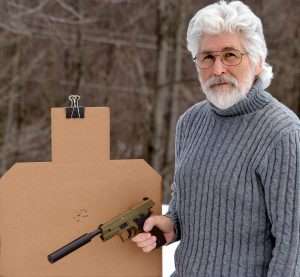
For the price of a faux suppressor and none of the complications of purchasing a real one for a cartridge-firing semi-auto (have been there and done that as shown in the accompanying photos), you can’t beat the look of the Sig Sauer P226 ASP when you thread on that 5.5 inch steel tube. You won’t hear silence, just the sound of satisfaction.
A Word About Safety
Blowback action airguns provide the look, feel and operation of their cartridge-firing counterparts and this is one reason why they have become so popular. Airguns in general all look like guns, blowback action models more so, and it is important to remember that the vast majority of people can’t tell an airgun from a cartridge gun. Never brandish an airgun in public. Always, and I can never stress this enough, always treat an airgun as you would a cartridge gun. The same manual of operation and safety should always apply.
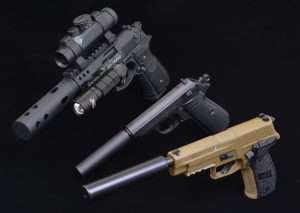

Thanks for this report. Very well written and easy to understand. But now explain something else about the Sig faux suppressor. You reported that its effective internal diameter is equivalent to the total outside diameter of 23.81 mm because it does not have a 7.93 mm diameter internal tube running down the entire length.
This is my question. Is it even remotely possible that a pellet could emerge from the barrel with enough instability that it fails to emerge from the end of the suppressor all because the suppressor does not have a 7.93 mm diameter tube to guide the pellet to the suppressor muzzle opening?
I believe the Gamo PT-85 Tactical has a faux suppressor that actually hides the barrel extension giving it an actual total barrel length of 12 inches.
This is a much more positive use of the faux suppressor to increase the barrel length by almost the whole length of the suppressor itself; which also gives it a much higher fps number than the regular PT-85 with no faux suppressor….
The Umarex CP99 Nighthawk was another excellent design based off the Beretta XX-TREME.
WE makes a Makarov PMM airgun licensed from the Russian Baikal Armory. It comes with a 4″ faux noise suppressor. Inside the suppressor is a true 4″ barrel extension that adds 32-% to the projectile’s muzzle velocity and 75-% to its muzzle kinetic energy!
Another item regarding noise suppression. If the muzzle velocity exceeds the speed of sound, then the projectile’s sonic boom is unaffected because the shock wave and accompanying sonic boom are generated after the bullet leaves the muzzle+suppressor assembly. I am regularly amused by movies with snipers using suppressed rifles, such as 50 cal BMG or Lapua Magnum 338, that obviously are well into the realm of supersonic (2500+ fps) speed; yet one can barely hear it when fired. If the target is 2000+ yards out, then yes the projectile’s speed might be subsonic with no shock wave or sonic boom.